
The Stapelburg Position, 1985
5th October 2023, 0 Comments
Modern Wars, Cold War Commander 2, 1/300 scale
This week – like I do every month – I had to miss a club night, due to a veterans’ meeting, the RNA. Fortunately, this month Sean 2 stepped up to the plate, and offered to do the blog, reporting on the game the two Seans played in my absence. So – here you go; This week, Angus was otherwise occupied so the two Seans – myself and Sean 1 – decided to play a short “Cold War Gone Hot” game using the Cold War Commander ruleset. Angus kindly asked me if I would write a blog of the game………so here we are, my first guest blog….writing as Sean 2.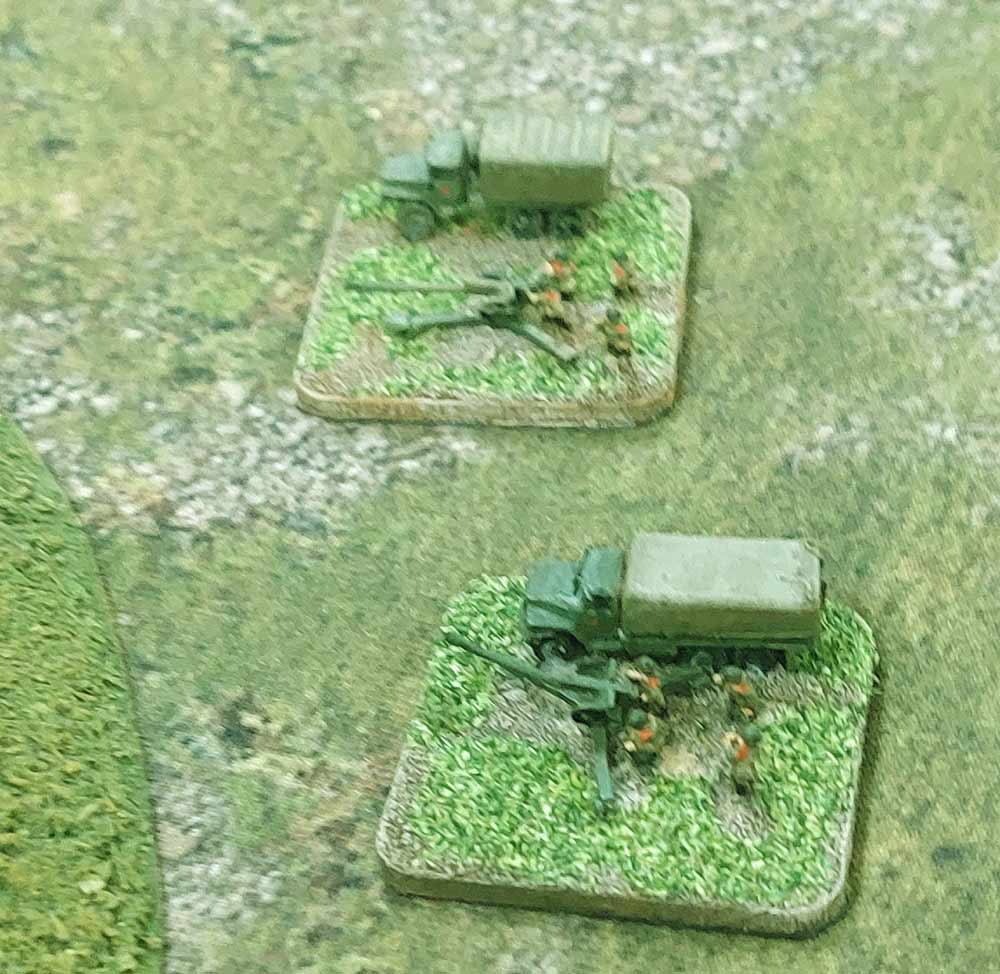 Both of us are getting to know these rules as they have a heap of nuances that are hidden in the explanatory scenarios in the copious text. I generally find such comprehensive rulesets a little daunting, but as Sean 1 suggested that they must be in this period due to the complexity of the weapons and command and control issues that arise when moving troops on the battlefield. So, this game was approached in the mindset of experimentation – with artillery being used by the soviets for the first time and an increased number of units on the battlefield compared to our usual games.
Both of us are getting to know these rules as they have a heap of nuances that are hidden in the explanatory scenarios in the copious text. I generally find such comprehensive rulesets a little daunting, but as Sean 1 suggested that they must be in this period due to the complexity of the weapons and command and control issues that arise when moving troops on the battlefield. So, this game was approached in the mindset of experimentation – with artillery being used by the soviets for the first time and an increased number of units on the battlefield compared to our usual games.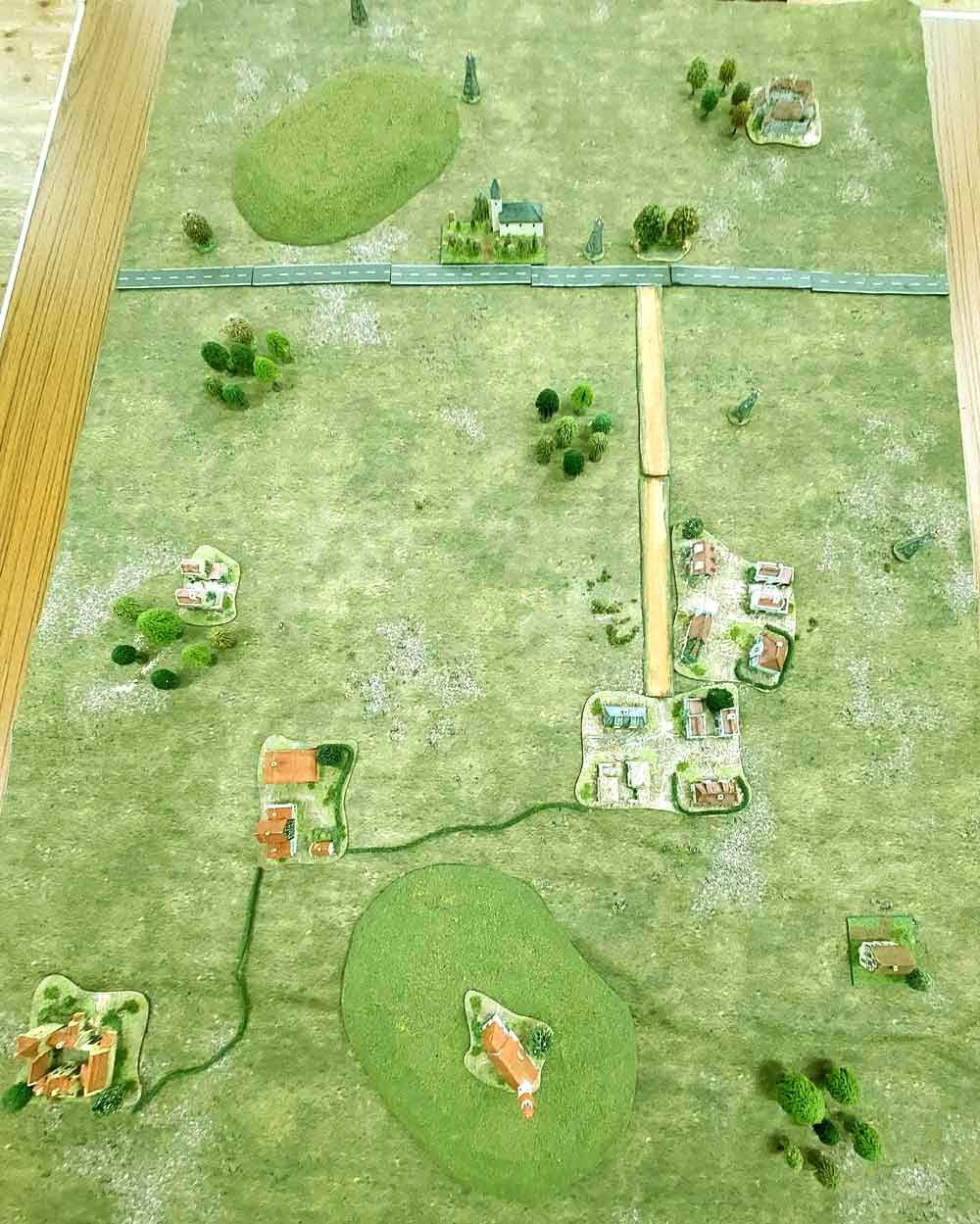 The scenario involved a small Soviet probing force performing a reconnaissance in force somewhere on the West German border in perhaps 1985. I commanded the Soviets as usual which comprised a small unit of T-55 tanks supported by a unit of infantry and three 122mm artillery batteries.
The scenario involved a small Soviet probing force performing a reconnaissance in force somewhere on the West German border in perhaps 1985. I commanded the Soviets as usual which comprised a small unit of T-55 tanks supported by a unit of infantry and three 122mm artillery batteries.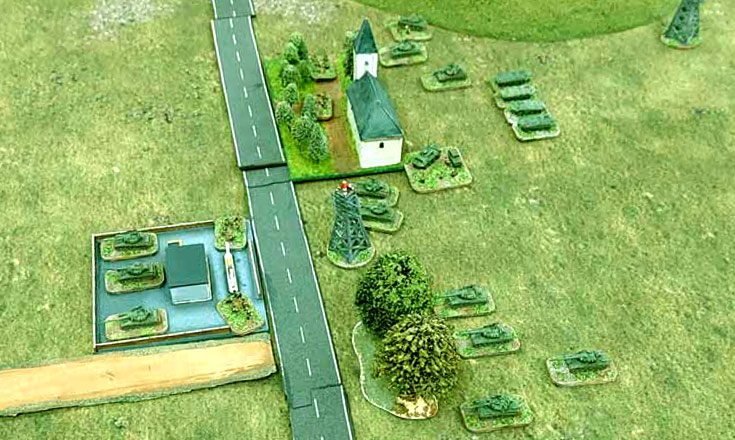 I deployed first and placed a combined battlegroup in Sean 1’s beloved petrol station (on reflection perhaps not such a good idea) with the rest of the T55’s in support. The artillery I placed behind a large hill. A move which on the face of it was good thinking, but I had neglected to place the command HQ on the hill giving them a line of site over the battlefield and to the artillery batteries. Hence, they remained silent for the first turn as Sean1 deployed behind the far hill.
I deployed first and placed a combined battlegroup in Sean 1’s beloved petrol station (on reflection perhaps not such a good idea) with the rest of the T55’s in support. The artillery I placed behind a large hill. A move which on the face of it was good thinking, but I had neglected to place the command HQ on the hill giving them a line of site over the battlefield and to the artillery batteries. Hence, they remained silent for the first turn as Sean1 deployed behind the far hill.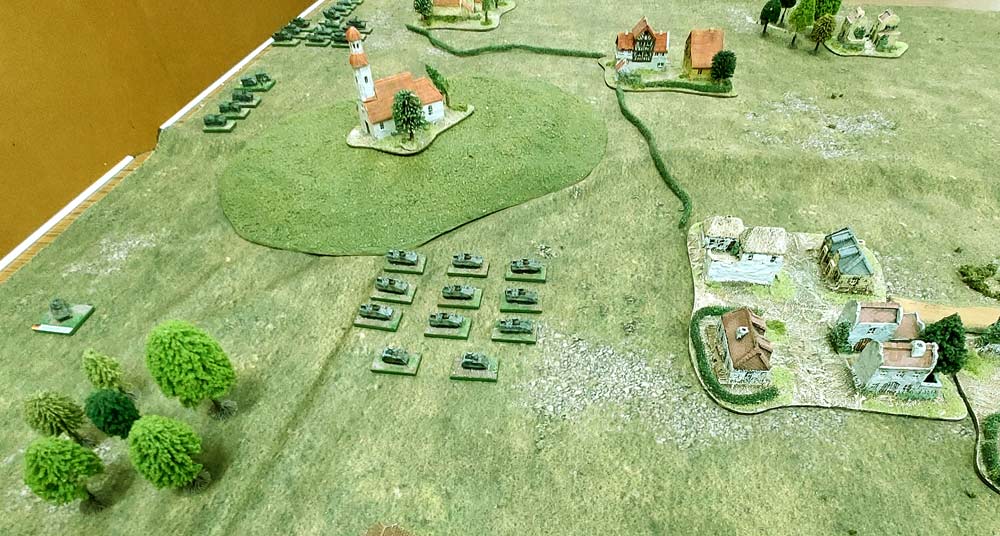 Initially the Soviets could see nothing and so in a spirit of reckless abandon I pressed forward with a unit of 4 T55s to the south of the town of Stapelburg. I left the rest of the tanks in support and moved two infantry units into the woods to the west of the petrol station – ready to move into the town if no enemy units were discovered by the tank force who were, it has to said, acting as decoy ducks.
Initially the Soviets could see nothing and so in a spirit of reckless abandon I pressed forward with a unit of 4 T55s to the south of the town of Stapelburg. I left the rest of the tanks in support and moved two infantry units into the woods to the west of the petrol station – ready to move into the town if no enemy units were discovered by the tank force who were, it has to said, acting as decoy ducks.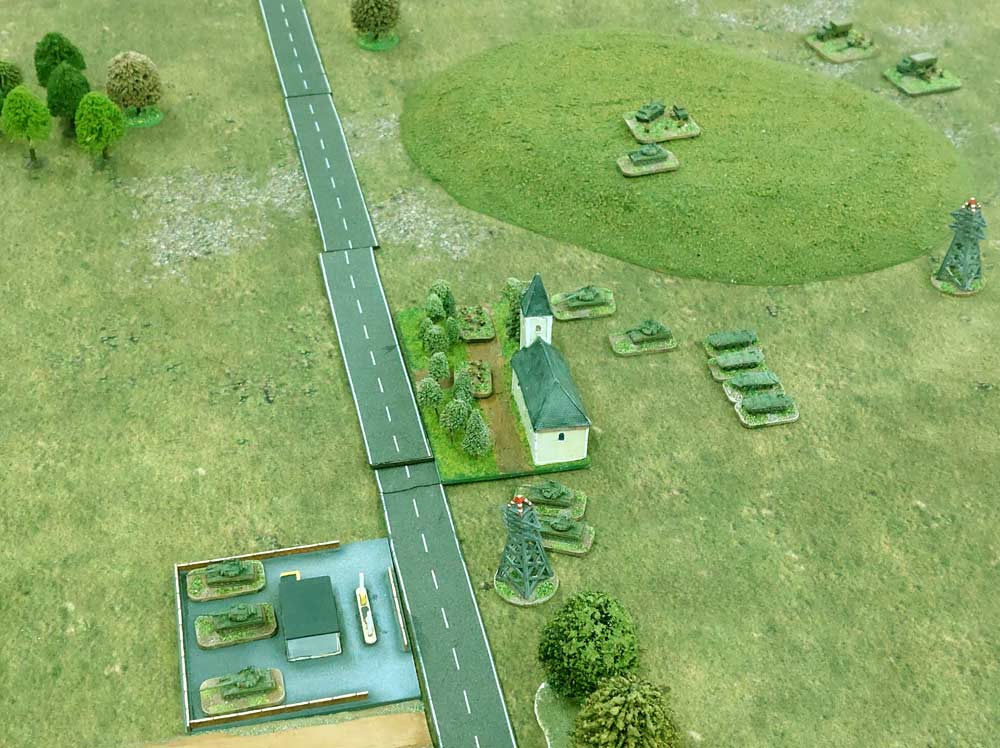 The Soviet plan then started to unravel – my tank force lost contact with the Commander after a terrible dice throw and so halted in open ground. They were now sitting ducks for the huge NATO forces now moving rapidly from behind the hill. However, the Soviet commander took a chance and ordered his tanks south of the town to open opportunity fire on one of the Leopard tanks moving across their front.
The Soviet plan then started to unravel – my tank force lost contact with the Commander after a terrible dice throw and so halted in open ground. They were now sitting ducks for the huge NATO forces now moving rapidly from behind the hill. However, the Soviet commander took a chance and ordered his tanks south of the town to open opportunity fire on one of the Leopard tanks moving across their front.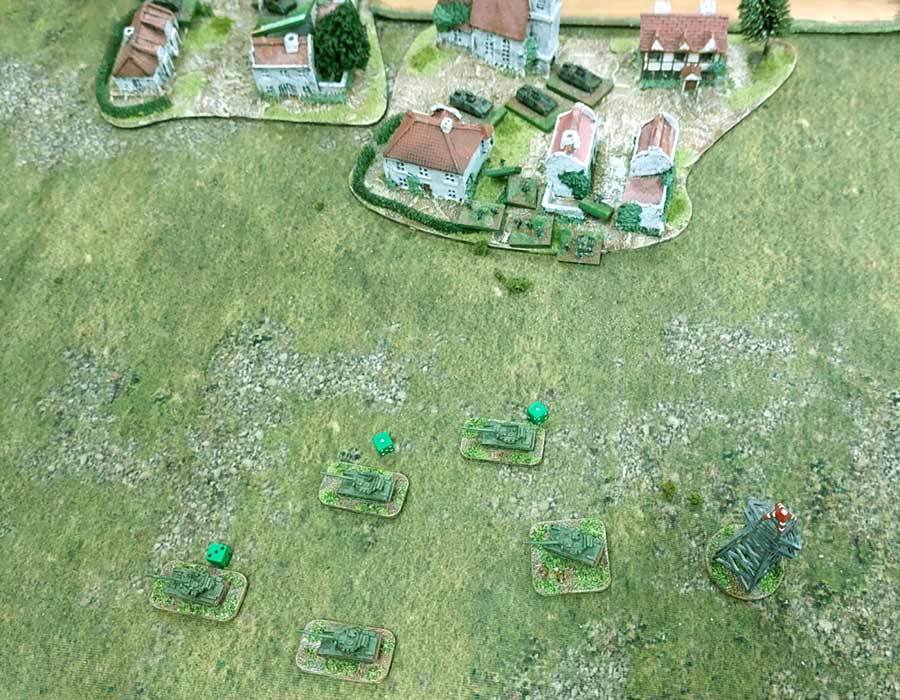 They were in luck as, firstly they were enabled to fire and secondly their concentrated fire smashed one of the Leopard units to pieces. At this point it is probably a good idea to explain that each base represents a unit of individual tanks and that it is almost impossible for soviet tanks to destroy such a unit unless several tanks concentrate their fire. Otherwise, if Soviet tanks fire one on one then each enemy unit is only suppressed – halts and can only retire – and then at the end of the move all suppression counters are removed!
They were in luck as, firstly they were enabled to fire and secondly their concentrated fire smashed one of the Leopard units to pieces. At this point it is probably a good idea to explain that each base represents a unit of individual tanks and that it is almost impossible for soviet tanks to destroy such a unit unless several tanks concentrate their fire. Otherwise, if Soviet tanks fire one on one then each enemy unit is only suppressed – halts and can only retire – and then at the end of the move all suppression counters are removed!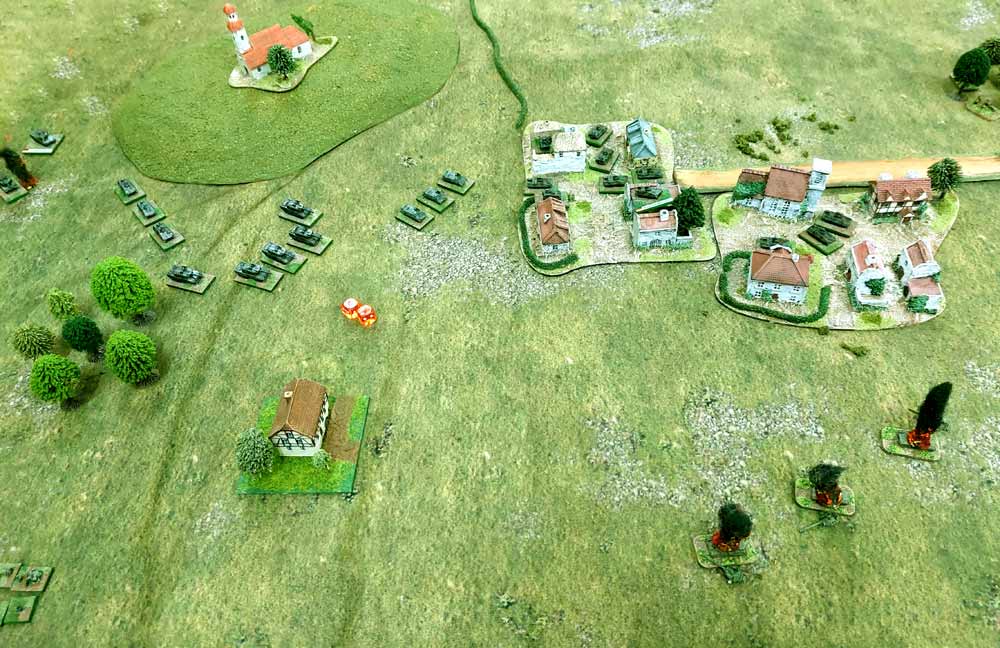 This confused and frustrated us in the first games we played using these rules, but started to make sense as we played more experimental games. The Soviet T55 force now tried to fire again and failed to activate. A somewhat alarming prospect was now emerging as a large NATO infantry force surged into the town of Stapelburg as the newly emerging Leopard force began to open fire on my small tank force. I was outflanked and outgunned!
This confused and frustrated us in the first games we played using these rules, but started to make sense as we played more experimental games. The Soviet T55 force now tried to fire again and failed to activate. A somewhat alarming prospect was now emerging as a large NATO infantry force surged into the town of Stapelburg as the newly emerging Leopard force began to open fire on my small tank force. I was outflanked and outgunned!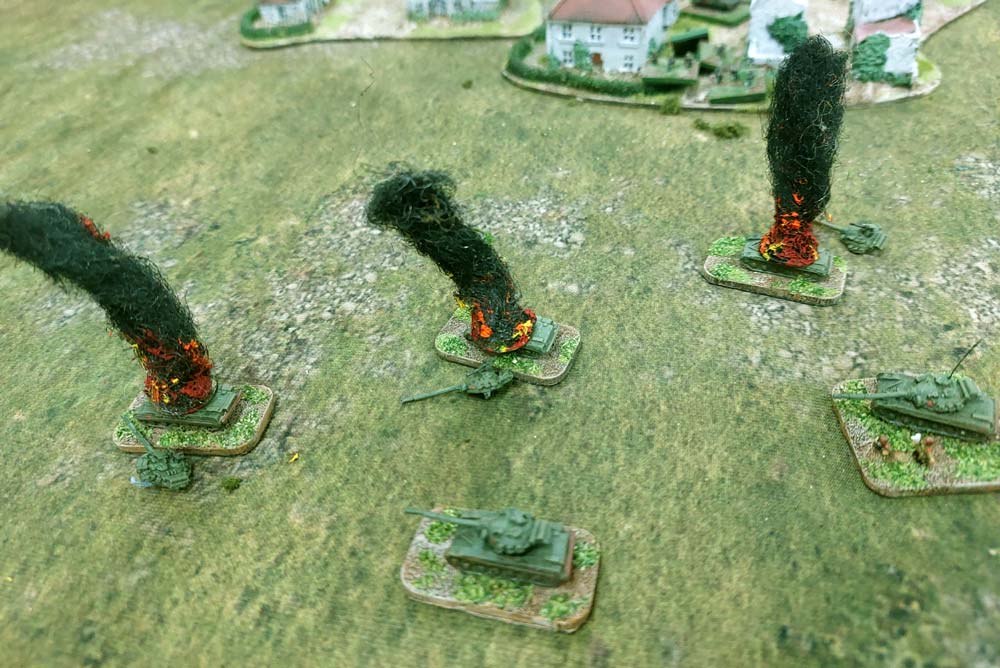 The Soviets then moved their CO forward to help with communications, but it was too late. The combined fire from the Leopard force to their front and the debussing infantry in the town quickly reduced the Soviet tank force to flaming scrap metal. My infantry force in the wood to the east of the town declared that discretion was the better part of valour and stayed where they were. Their decision was a good one as a looming unit of NATO SP artillery had rumbled into the village to the north and so was ready to lay down opportunity fire on the open ground to the front of the soviet infantry. At best they would be pinned down while crossing to attack Stapelburg or at worst suffer devastating losses. Sitting still and awaiting the inevitable assault now seemed the best option.
The Soviets then moved their CO forward to help with communications, but it was too late. The combined fire from the Leopard force to their front and the debussing infantry in the town quickly reduced the Soviet tank force to flaming scrap metal. My infantry force in the wood to the east of the town declared that discretion was the better part of valour and stayed where they were. Their decision was a good one as a looming unit of NATO SP artillery had rumbled into the village to the north and so was ready to lay down opportunity fire on the open ground to the front of the soviet infantry. At best they would be pinned down while crossing to attack Stapelburg or at worst suffer devastating losses. Sitting still and awaiting the inevitable assault now seemed the best option.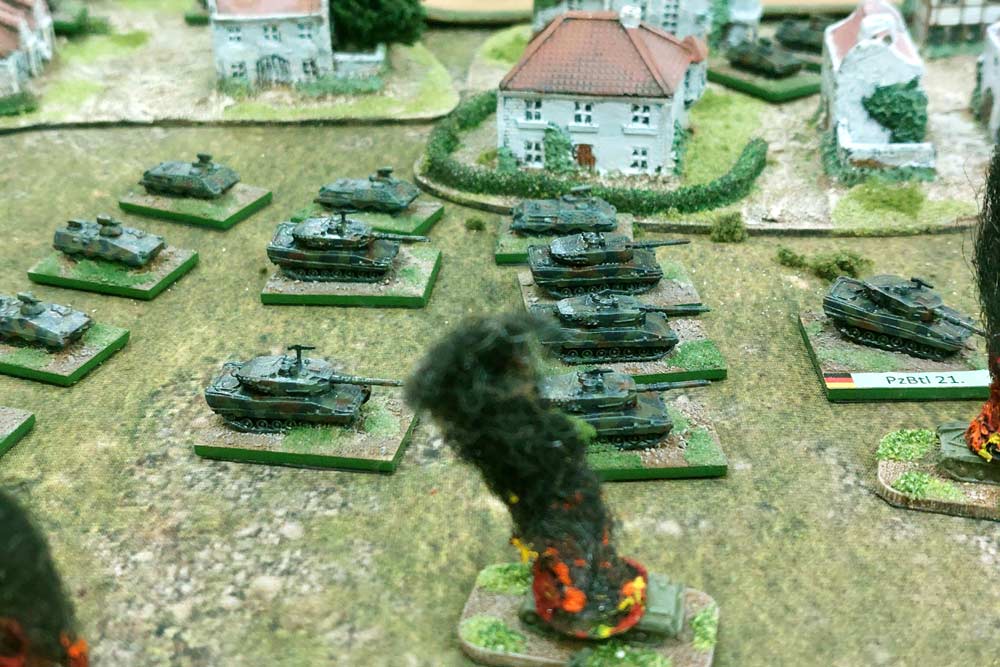 By now the Soviets had moved their CO into an observation position on the hill and an artillery barrage was ordered into the infantry in the town. Unfortunately for the soviets, The NATO infantry who had wreaked so much havoc on the Soviet tank force, had sought shelter in their APC’s and so the barrage only managed to suppress one unit – and of course cause considerable damage to the town. The writing was now on the wall as Sean1’s huge Leopard armoured brigade moved forward and opened fire on the remaining soviet tanks in view. It was a massacre as the remaining tanks exploded – leaving the commander to flee for his life. In vain three more Soviet tank units were moved forward from behind the petrol station, but halted as the communication net collapsed again.
By now the Soviets had moved their CO into an observation position on the hill and an artillery barrage was ordered into the infantry in the town. Unfortunately for the soviets, The NATO infantry who had wreaked so much havoc on the Soviet tank force, had sought shelter in their APC’s and so the barrage only managed to suppress one unit – and of course cause considerable damage to the town. The writing was now on the wall as Sean1’s huge Leopard armoured brigade moved forward and opened fire on the remaining soviet tanks in view. It was a massacre as the remaining tanks exploded – leaving the commander to flee for his life. In vain three more Soviet tank units were moved forward from behind the petrol station, but halted as the communication net collapsed again.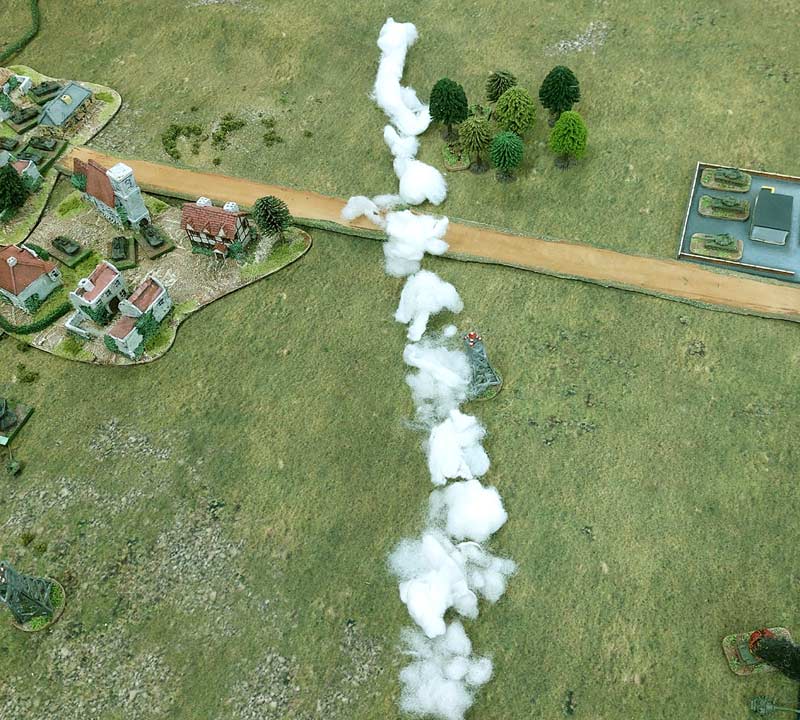 It was now approaching the final stages and the Soviets were expecting a storm of steel and explosives to land on their positions. But no…….Sean 1 opted to fire a lengthy smoke barrage into the open ground between the wood and Stapelburg. The only option was for the Soviets to withdraw as such an overwhelming force closing to short range would make short work of any unit foolhardy enough to try and fight back! Sean 2 opted to retire and take on board the lessons learned.
It was now approaching the final stages and the Soviets were expecting a storm of steel and explosives to land on their positions. But no…….Sean 1 opted to fire a lengthy smoke barrage into the open ground between the wood and Stapelburg. The only option was for the Soviets to withdraw as such an overwhelming force closing to short range would make short work of any unit foolhardy enough to try and fight back! Sean 2 opted to retire and take on board the lessons learned.




